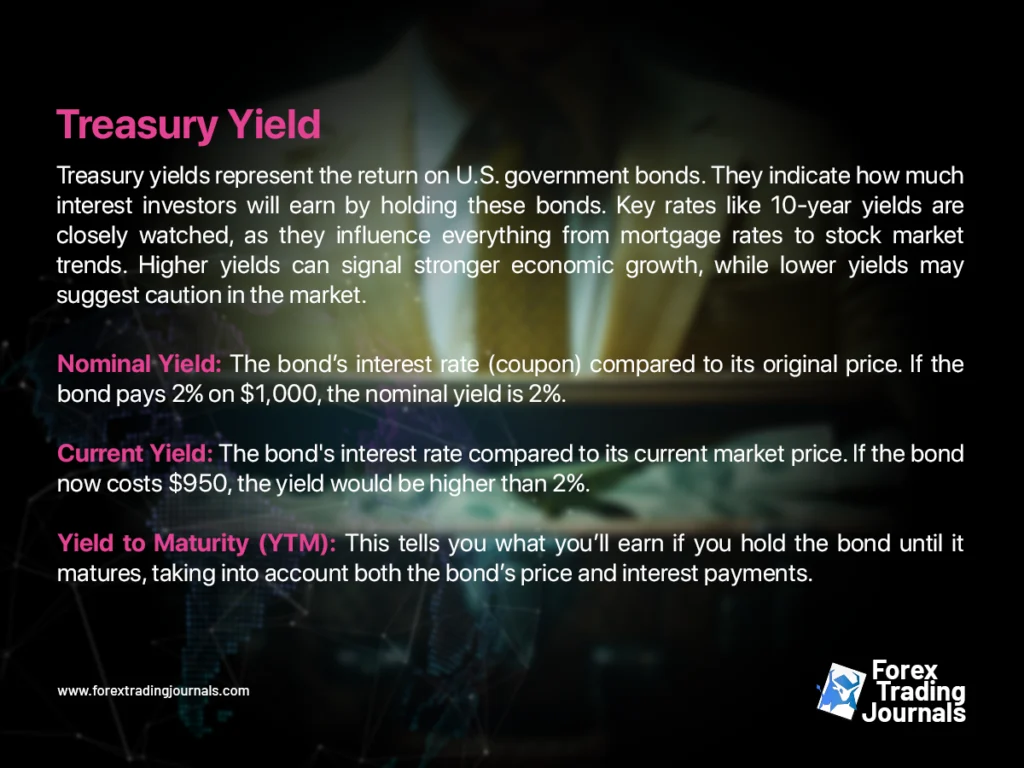Treasury yields refer to the interest you earn when you invest in U.S. government bonds, like Treasury bills (T-bills), notes, or bonds. These bonds are issued by the U.S. government to borrow money. Treasury yields impact things like loan interest rates, stock prices, and the overall economy.
1. What Are Treasury Yields?
When you buy a Treasury bond, you’re lending money to the U.S. government. In return, they pay you interest. This interest is called the “yield.” The yield changes depending on how much people are willing to pay for the bond and how long it lasts (its maturity).
- T-bills: Short-term, lasting from a few weeks to a year.
- T-notes: Medium-term, lasting 2 to 10 years.
- T-bonds: Long-term, lasting 20 to 30 years.
The yield is the return you get for holding one of these bonds, and it’s expressed as a percentage.
2. How Do Treasury Yields Work?
When you buy a bond, the government promises to pay you a fixed interest rate, called the coupon rate. The yield is based on this rate and the current price of the bond.
- Bond Price and Yield: When bond prices go up, yields go down. When bond prices go down, yields go up. This happens because the amount of interest you earn stays the same, but if the price of the bond changes, the percentage return (yield) changes too.
For example, if you buy a $1,000 bond that pays 2% interest, you get $20 each year. If people are willing to pay more than $1,000 for the bond, the yield will drop, and if they pay less, the yield will rise.
3. Types of Treasury Yields
- Nominal Yield: The bond’s interest rate (coupon) compared to its original price. If the bond pays 2% on $1,000, the nominal yield is 2%.
- Current Yield: The bond’s interest rate compared to its current market price. If the bond now costs $950, the yield would be higher than 2%.
- Yield to Maturity (YTM): This tells you what you’ll earn if you hold the bond until it matures, taking into account both the bond’s price and interest payments.

4. What Is the Yield Curve?
The yield curve is a chart that shows the yields for bonds with different maturities. It’s important because it can give clues about where the economy is headed.
- Normal Yield Curve: This is when long-term bonds have higher yields than short-term ones. It’s a sign of a healthy economy.
- Inverted Yield Curve: When short-term bonds have higher yields than long-term ones, it often means investors expect a slowdown or recession.
- Flat Yield Curve: When short- and long-term yields are about the same, it signals uncertainty in the market.
5. What Affects Treasury Yields?
Several things can cause Treasury yields to go up or down:
- Interest Rates: When the Federal Reserve (the central bank) raises or lowers interest rates, Treasury yields often follow. Higher rates usually mean higher yields, and lower rates mean lower yields.
- Inflation: If investors expect inflation to rise, they demand higher yields to make up for the loss of buying power over time.
- Economic Growth: When the economy is growing quickly, yields tend to rise because investors expect higher returns in the future.
- Supply and Demand: If many people want to buy Treasury bonds, the prices go up and yields go down. If fewer people want them, prices fall and yields go up.
6. Why Are Treasury Yields Important?
Treasury yields affect many parts of the economy:
- Interest Rates on Loans: Treasury yields help set interest rates for things like mortgages, car loans, and credit cards. If Treasury yields go up, these rates often go up too.
- Stock Market: When Treasury yields are low, people often invest more in stocks, driving up prices. When yields rise, investors may move their money from stocks to bonds, lowering stock prices.
- Government Borrowing Costs: Higher yields mean it costs the U.S. government more to borrow money, which can affect government spending.
7. Recent Trends in Treasury Yields
Treasury yields go up and down based on what’s happening in the world:
- COVID-19: During the pandemic, yields dropped to record lows because investors wanted the safety of government bonds.
- Inflation: In 2023 and 2024, yields have risen as inflation picked up and the Federal Reserve raised interest rates to control it.
- Global Events: Political uncertainty or conflict can push investors to buy Treasury bonds, which makes yields drop.
Wrapping up
Treasury yields are important to understand because they influence interest rates, economic growth, and the overall financial markets. Whether you’re an investor or just interested in how the economy works, keeping an eye on Treasury yields can help you better understand the bigger picture.



